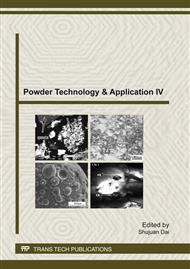p.17
p.21
p.26
p.30
p.35
p.41
p.46
p.55
p.59
Influence of DCCF on the Properties of Asphalt by DSC
Abstract:
The diatomite-cellulose composite fiber (DCCF) was used to modify the asphalt for pavement, and then the DCCF-modified asphalt was researched by DSC from the point of congeries state and energy change, the temperature and heat absorption of the phase transition as index, combined with the macro-road performance of asphalt. The results showed that the high/low-temperature performance and temperature susceptibility of the DCCF-modified asphalt were all improved obviously and would be the best if the modifier dosage was 0.5%. DSC could effectively explain the influence of DCCF on the properties of asphalt from the view point of congeries state and energy change, and the variation were consistent with the Macro-mechanical properties test results of the modified asphalt.
Info:
Periodical:
Pages:
35-40
Citation:
Online since:
January 2012
Authors:
Price:
Сopyright:
© 2012 Trans Tech Publications Ltd. All Rights Reserved
Share:
Citation:


